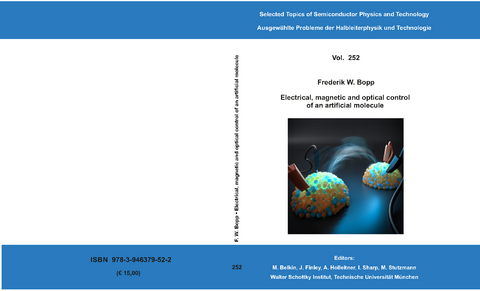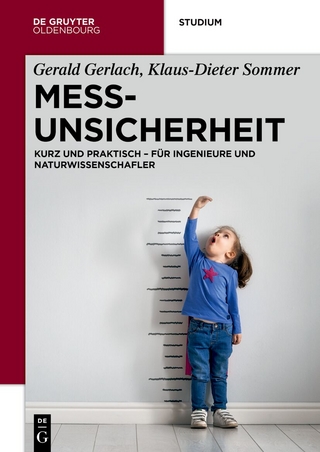Electrical, magnetic and optical control of an artificial molecule
Seiten
2023
Verein zur Förderung des Walter Schottky Instituts der Technischen Universität München (Verlag)
978-3-946379-52-2 (ISBN)
Verein zur Förderung des Walter Schottky Instituts der Technischen Universität München (Verlag)
978-3-946379-52-2 (ISBN)
- Titel nicht im Sortiment
- Artikel merken
Stable, scalable and efficiently controllable qubits are needed to enable breakthroughs in quantum information technologies. Charge spin qubits in tunnel-coupled pairs of self-assembled quantum dots (QDs), called quantum dot molecules (QDMs), meet these requirements. QDMs combine the advantages of two systems: Strong interaction with light, robust optical selection rules, and transform-limited linewidths of single QDs and the extended coherence time of decoherence-free subspaces in few-qubit systems. On this basis, QDMs are promising for use as quantum repeater nodes or for the generation of one- and two-dimensional photonic cluster states. To enable these applications, simultaneous control of charge state, orbital coupling and charge spin in a QDM is required.
In this thesis, I present a novel sample design, which facilitates the simultaneous setting of the charge state and the orbital coupling. This is achieved by utilizing a four-phase optical and electrical measurement scheme based on optical excitation and tunneling ionization. Thereby, we are able to create one and two charge states with a fidelity of (93.5 ± 0.8) % and (80.5 ± 1.3) %, respectively. Independently, we were able to tune the orbital coupling.
The developed measurement sequence is applied to investigate the interaction of tunnel-coupled charge states with light fields. By coherently driving a direct, indirect, and hybridized exciton state, I demonstrate the electric tunability of the transition dipole moment (TDM) by a factor of three between (231 ± 8) Debye and (674 ± 9) Debye. These results are used to quantify an inter-dot transfer of charges, mediated by phonon emission and absorption. The observed phonon absorption rates amount to 0.2 〖"ns" 〗^(-1) at 10 K and are comparable to the radiative lifetime of indirect excitons. This suggests the operation of QDMs below 4 K. Theoretical models are introduced to describe and predict the phonon absorption and emission rates as well as the electric dependence of the TDM. The evaluation of the TDM and the coherent driving of direct and indirect excitons is the first step towards the generation of one-dimensional cluster states. The second step is the initialization and readout of the charge spin. We show the resonant excitation of a charge spin qubit in a magnetic field to enable its initialization with a fidelity of (99.4 ± 0.2) %. This corresponds to an ensemble temperature of 28 mK.
The results presented in this thesis pave the way towards complete spin control of arbitrary charge states with tunable orbital coupling in single QDMs.
In this thesis, I present a novel sample design, which facilitates the simultaneous setting of the charge state and the orbital coupling. This is achieved by utilizing a four-phase optical and electrical measurement scheme based on optical excitation and tunneling ionization. Thereby, we are able to create one and two charge states with a fidelity of (93.5 ± 0.8) % and (80.5 ± 1.3) %, respectively. Independently, we were able to tune the orbital coupling.
The developed measurement sequence is applied to investigate the interaction of tunnel-coupled charge states with light fields. By coherently driving a direct, indirect, and hybridized exciton state, I demonstrate the electric tunability of the transition dipole moment (TDM) by a factor of three between (231 ± 8) Debye and (674 ± 9) Debye. These results are used to quantify an inter-dot transfer of charges, mediated by phonon emission and absorption. The observed phonon absorption rates amount to 0.2 〖"ns" 〗^(-1) at 10 K and are comparable to the radiative lifetime of indirect excitons. This suggests the operation of QDMs below 4 K. Theoretical models are introduced to describe and predict the phonon absorption and emission rates as well as the electric dependence of the TDM. The evaluation of the TDM and the coherent driving of direct and indirect excitons is the first step towards the generation of one-dimensional cluster states. The second step is the initialization and readout of the charge spin. We show the resonant excitation of a charge spin qubit in a magnetic field to enable its initialization with a fidelity of (99.4 ± 0.2) %. This corresponds to an ensemble temperature of 28 mK.
The results presented in this thesis pave the way towards complete spin control of arbitrary charge states with tunable orbital coupling in single QDMs.
| Erscheinungsdatum | 30.12.2023 |
|---|---|
| Sprache | englisch |
| Maße | 150 x 210 mm |
| Themenwelt | Naturwissenschaften ► Physik / Astronomie |
| Schlagworte | quantum dot molecule • Quantum Technology • spin qubit |
| ISBN-10 | 3-946379-52-4 / 3946379524 |
| ISBN-13 | 978-3-946379-52-2 / 9783946379522 |
| Zustand | Neuware |
| Haben Sie eine Frage zum Produkt? |
Mehr entdecken
aus dem Bereich
aus dem Bereich
von den Werkzeugen über Methoden zum TQM
Buch | Softcover (2024)
Springer Fachmedien (Verlag)
32,99 €
kurz und praktisch - für Ingenieure und Naturwissenschafler
Buch | Softcover (2024)
De Gruyter Oldenbourg (Verlag)
44,95 €




